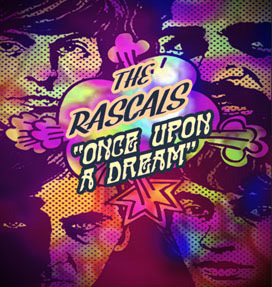
Despite delivering some of the biggest hits of the sixties, The Rascals never quite solidified themselves as a household classic rock name, quickly and quietly burning out as soon as the calendar flipped to 1970. Garage rock aficionado Steve Van Zandt of the E Street Band convinced the original four members to reunite for a private benefit in 2010, and Van Zandt has again spearheaded a Rascals return, this time for the public with six shows at Port Chester’s Capitol Theatre. Billed as “Once Upon A Dream,” the elaborate show, co-produced by Van Zandt and famed lighting designer Marc Brickman, was part concert, part biopic.
As The Rascals deserved far more than their slide into relative obscurity, Van Zandt and Brickman gave them a more appropriate reunion, one that both celebrated their music and told their story. Of course the heart of the show was the band itself and their playing, which was remarkably tight, especially considering the long separation. The four original Rascals – Eddie Brigati (vocals), Felix Cavaliere (organ and vocals), Gene Cornish (guitar) and Dino Danelli (drums) – have lost little to nothing over the past forty years apart. Eddie and Felix sounded powerful and soulful, Cornish’s guitar playing was sharp with that vintage garage rock crunch, and Dino’s drumming still the propulsive force driving the band.
As a band most famous for their hits, The Rascals were always underrated as musicians. But between Dino’s freewheeling drumming Cornish’s jagged, rockabilly-influenced guitar, The Rascals were able to carve out a distinctive sound of their own. Over the course of the show, the band played just about everything – hits like “Good Lovin’,” “People Got To Be Free” and “Groovin’;” as well as long-forgotten album tracks like “Sueno” and “My Hawaii.” Though perhaps best remembered as a rhythm and blues garage rock band, they eventually dove full tilt into the Summer of Love, pushing their songs towards psychedelia. Whether playing direct, punchy soul or sunshine-filled flower power, The Rascals had, and still have, the musicianship to pull both styles off with originality and flair.
Between every few songs, they paused playing as interviews with the band members and other video footage played on a screen behind the band. Sometimes these little video segments even came mid-song, but rarely slowed momentum. Instead, the interviews were a vital part of the show, featuring amusing tales and moments of poignant reflection where the bandmates shared their genuine love for, and pride in, the music they created together.
To call the project ambitious is a gross understatement. Van Zandt started a Kickstarter campaign to help pay for production costs, and he and Brickman put every cent to good use. Brickman took full advantage of The Capitol Theatre’s brand new, state-of-the-art lighting system, as colorful psychedelic washes splashed on the screen behind the band as they played, as well as vintage images of the band and the 1960s. With Brickman and Van Zandt lending their manic attention to detail to the project, every aspect of the show – ranging from the ornate venue and its sound and lights to the interviews and vintage images – was absolutely perfect. All The Rascals had to do was show up and play, which they did with the enthusiasm and delight of a band that has been eagerly waiting forty years for this moment.


No Comments comments associated with this post